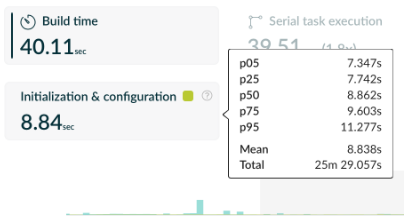April 2018
Table of Contents
Welcome to the April Newsletter!
This issue covers 2 big Gradle releases: Gradle Enterprise 2018.2 and Gradle 4.7, a post on quantifying the costs of builds, and new Gradle docs and guides.
From the Community
- Gradle Rust and Cargo Plugins — A collection of plugins from Schalk Cronjé that allows developers to integrate Rust in a polyglot project.
- How to use Gradle inside Visual Studio Code to build your Kotlin/Native applications — In this blog post, Martin Majewski automates a basic Kotlin/Native project using Gradle and Visual Studio Code.
- How to use JUnit 5 with Gradle — Gradle build configuration scripts for configuring the JUnit + Jupiter engine and adding better test logging by Jonas Havers.
- Getting started with Docker Compose — Ben Muschko shows how to manage multiple containers with Docker Compose and Gradle.
- Kotlin DSL to Write Gradle Scripts on Android — A step by step walkthrough converting an Android build to Kotlin DSL by Antonio Leiva.
Have a blog post or plugin you’d like to see featured here? Just send us an email with the details to newsletter@gradle.com.
Gradle Enterprise 2018.2

Gradle Enterprise 2018.2 introduces 3 substantial new tools for build performance and debugging.
- Build performance dashboard that provides insights across all builds
- Preemptive build cache replication for faster build cache hits
- Console logging per task in build scans
These features and more described in the Gradle Enterprise 2018.2 release notes.
By the way, if you’re curious what Gradle Enterprise is or how it works, you can watch Gradle CEO Hans Dockter demonstrate it in this video.
Gradle 4.7
Another featureful release, Gradle 4.7 includes:
- Incremental annotation processor APIs
- Java 10 runtime support
- Grouped non-interactive console logs
- Re-run failed tests first for quicker feedback
- Kotlin DSL v0.16, featuring new pre-compiled script plugins
Read the full release notes for examples and other features.
Quantifying the Costs of Builds

In another visionary piece, Hans Dockter calculates how a typical engineering team of 200 could save over a million dollars by improving their build time by 2.5 minutes.
This post is meant to provide a model on how to calculate the costs of your builds and the return you get on improving it.
You can read the full breakdown in the blog post on quantifying the costs of builds.
Further improved Gradle docs
Last but not least, we hope you find these new Gradle docs and tutorials useful:
- Building Java & JVM Projects
- Testing Java & JVM Projects
- Authoring Maintainable Build Scripts
- Base Plugin Reference
- Getting started guides for using Gradle with Jenkins and Travis CI
Your continued feedback is welcome; stay tuned for more updates.
Upcoming online training
- May 15-16: Introduction to Gradle
- May 24: Build Cache Deep Dive
- Jun 26-29: Advanced Gradle Fundamentals for Java/JVM
- Anytime: Maximizing Developer Productivity with Gradle Enterprise
Until next time!
—The Gradle Build Tool Team
If you have some news you’d like us to share in the next issue,
let us know using the #community-news channel on the Gradle Community Slack or by mentioning @Gradle on Twitter/X.
Until next time!
— The Gradle Team
|
Gradle Inc. | 2261 Market Street | San Francisco, CA 94114 |
||||
|
|
